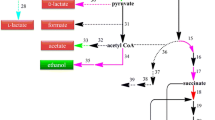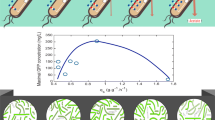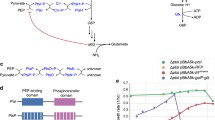Abstract
Thepet operon consists of genes coding for enzymes responsible for ethanol production and consists of pyruvate dehydrogenase and alcohol dehydrogenase II from the high-performance ethanologenZymomonas mobilis. This article describes the physiological influence ofpet expression inEscherichia coli B (ATCC 11303) in terms of growth rate and overall concentrations of cell mass and catabolic end products achieved under well-defined cultivation conditions that included constant pH and carbon (energy) limitation. Glucose, mannose, and xylose were used as substrates, because they represent the principal fermentable components of lignocellulosic biomass and because fermentation of these sugars involves different metabolic pathways. Two different types of ethanologenic recombinants were used—a strain in whichpet expression was via a multicopy plasmid (pLOI297) and a chromosomal integrant, strain KO11. Under the condition of sugar substrate limitation, there was no growth enhancement bypet expression with either glucose or mannose. Whereas the host strain produced exclusively lactic acid from glucose and mannose, both recombinants produced mostly ethanol. Both the plasmid-carrying strain and thepet integrant exhibited slower growth compared to the host culture with glucose or mannose as fermentation substrate. With mannose, the plasmid recombinant grew appreciably slower than either the host culture or the recombinant KO11. Use of a magnesium-deficient medium produced different results with glucose since substrate and turbidometric measurements proved to be unreliable in terms of estimating overall biomass levels. At pH 6.3,pet expression improved overall biomass yield; but at pH 7.0, the cell yields exhibited by the plasmid recombinant and the host strain were the same.E. coli B did not grow well on xylose as sole carbon source. With xylose,pet expression increased the growth rate, but had no effect on the overall biomass yield. In comparing our observations with the reports of others, it was concluded that the effect ofpet expression on growth ofE. coli is dependent on several different biochemical, physiological, genetic, and environmental factors, which largely precludes a statement of generality regarding this phenomenon.
Similar content being viewed by others
References
Knappe, J. (1987), inEscherichia coli and Salmonella typhimurium, vol. 1, Neidhart, F. C., ed., Academic, New York, pp. 151–155.
Tempest, D. W. and Neijssel, O. M. (1987), inEscherichia coli and Salmonella typhimurium, vol. 1, Neidhart, F. C., ed., Academic, New York, pp. 797–806.
Gottschalk, G. (1986), inBacterial Metabolism, 2nd ed., Springer-Verlag, New York, pp. 208–282.
Roos, J. W., McLaughlin, J. K., and Papoutsakis, E. T. (1985),Biotechnol. Bioeng. 27, 681–694.
Thauer, R. K., Jungermann, K., and Decker, K. (1977),Bacteriol. Rev. 41, 100–180.
Stouthamer, A. H. (1977), inMicrobial Energetics, 27th Symp. Soc. Gen. Microbiol., Haddock, B. A. and Hamilton, W. A., eds., Cambridge University Press, London, pp. 285–315.
Ingram, L. O., Conway, T., Clark, D. P., Sewell, G. W., and Preston, J. F. (1987),Appl. Environ. Microbiol. 53, 2420–2425.
Ingram, L. O., Conway, T., and Alterthum, F. (1991), United States Patent 5,000,000.
Ingram, L. O., Alterthum, F., Ohta, K., and Beall, D. S. (1990), inDevelopments in Industrial Microbiology, vol. 31, Pierce, G. E., ed., Elsevier Science, New York, pp. 21–30.
Alterthum, F. and Ingram, L. O. (1989),Appl. Environ. Microbiol. 54, 397–404.
Ingram, L. O. (1991), inEnergy from Biomass and Wastes XIV, Klass, D. L., ed.. Institute of Gas Technology, Chicago, IL, pp. 1105–1126.
Neale, A. D., Scopes, R. K., and Kelly, J. M. (1988),Appl. Microbiol. Biotechnol. 29, 162–167.
Holmes, W. H. (1986), inCurrent Topics in Cellular Regulation, vol. 28, Academic, New York, pp. 69–105.
Nimmo, H. G. (1987), inEscherichia coli and Salmonella, vol. 1, Neidhart, F. C., ed., Academic, New York, pp. 156–169.
Guest, J. R., Cole, S. T., and Jeyaseelan, K. (1981),J. Gen. Microbiol. 127, 65–79.
Diaz-Ricci, J. C., Tsu, M., and Bailey, J. E. (1992),Biotechnol. Bioeng. 39, 59–65.
Diaz-Ricci, J. C., Hitzmann, B., and Bailey, J. E. (1991),Biotechnol. Prog. 7, 305–310.
Ohta, K., Beall, D. S., Mejia, J. P., Shanmugam, K. T., and Ingram, L. O. (1991),Appl. Environ. Microbiol. 57, 893–900.
Lawford, H. G. and Rousseau, J. D. (1995),Appl. Biochem. Biotechnol. 51/52, 179–195.
Grohmann, K., Baldwin, E. A., Buslig, B. S., and Ingram, L. O. (1994),Biotechnol. Lett. 16, 281–286.
Grohmann, K., Cameron, R. G., and Buslig, B. S. (1995),Appl. Biochem. Biotechnol. 51/52, 423–435.
Lawford, H. G. and Rousseau, J. D. (1991),Appl. Biochem. Biotechnol. 28/29, 221–236.
Stouthamer, A. H. (1976), inYield Studies in Microorganisms, Meadowfield, Dewbury, UK.
Lawford, H. G. and Rousseau, J. D. (1992),Appl. Biochem. Biotechnol. 34/35, 185–204.
Lawford, H. G. and Rousseau, J. D. (1993),Appl. Biochem. Biotechnol. 39/40, 301–322.
Boyer, H. W. and Rouland-Dussoix, D. J. (1969),J. Mol. Biol. 41, 459–472.
Lui, G. W. and Strohl, W. R. (1990),Appl. Environ. Microbiol. 56, 1004–1011.
Smirova, G. V. and Oktybr’skii, O. N. (1985),Microbiology (USSR) 54, 205–209.
Smirova, G. V., and Oktybr’skii, O. N. (1985),Microbiology (USSR) 57, 446–451.
Diaz-Ricci, J. C., Regan, L., and Bailey, J. E. (1991),Biotechnol. Bioeng. 38, 1318–1324.
Lawford, H. G. and Rousseau, J. D. (1996),Appl. Biochem. Biotechnol. 57/58, 307–326.
Guimaraes, W. V., Dudley, G. L., and Ingram, L. O. (1992),Biotechnol. Bioeng. 40, 41–45.
Lawford, H. G., and Rousseau, J. D. (1993), inEnergy from Biomass and Wastes XVI, Klass, D. L., ed., Institute of Gas Technology, Chicago, IL, pp. 559–597.
Lawford, H. G. and Rousseau, J. D. (1993),Biotechnol. Lett. 15, 615–620.
Barbosa, M. F. S., Beck, M. J., Fein, J. E., Potts, D., and Ingram, L. O. (1992),Appl. Environ. Microbiol. 58, 1382–1384.
Ohta, K., Alterhum, F., and Ingram, L. O. (1990),Appl. Environ. Microbiol. 56, 463–465.
Beall, D. S., Ohta, K., and Ingram, L. O. (1991),Biotechnol. Bioeng. 38, 296–303.
Lawford, H. G. and Rousseau, J. D. (1992), inEnergy from Biomass and Wastes XV, Klass, D. L., ed., Institute of Gas Technology, Chicago, IL, pp. 583–622.
Lawford, H. G. and Rousseau, J. D. (1994),Appl. Biochem. Biotechnol. 45/46, 367–382.
Lawford, H. G. and Rousseau, J. D. (1991),Biotechnol. Lett. 13, 191–196.
Kracke-Hem, H. A., Rinas, U., Hitzmann, B., and Schügerl, K. (1991),Curr. Microbiol. 23, 71–74.
Yang, X.-M. (1992),J. Biotechnol. 23, 271–389.
Yee, L. and Blanch, H. W. (1992),Bio/Technol. 10, 1550–1556.
Yee, L. and Blanch, H. W. (1993),Biotechnol. Bioeng. 41, 221–230.
Landwall, P. and Holme, T. (1977),J. Gen. Microbiol. 103, 353–358.
LeVine, S. M., Ardeshir, F., and Ferro-Luzzi Ames, G. (1980),J. Bacteriol. 143, 1081.
Koh, B. T., Nakashimada, U., Pfeiffer, M., and Yap, M. G. S. (1992),Biotechnol. Lett. 14, 1115–1118.
Lawford, H. G. and Rousseau, J. D. (1996),Appl. Biochem. Biotechnol. 57/58, 293–305.
Lawford, H. G. and Rousseau, J. D. (1994),Appl. Biochem. Biotechnol. 45/46, 349–365.
Author information
Authors and Affiliations
Rights and permissions
About this article
Cite this article
Lawford, H.G., Rousseau, J.D. The relationship between growth enhancement andpet expression inEscherichia coli . Appl Biochem Biotechnol 57, 277–292 (1996). https://doi.org/10.1007/BF02941708
Issue Date:
DOI: https://doi.org/10.1007/BF02941708




